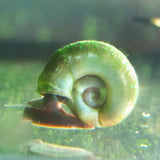Ramshorn Snails Planorbis Corneus Aquatic Pond Molluscs
Ramshorn snails (Planorbis corneus) are small, freshwater snails commonly kept in aquariums and ponds. They have a distinctive spiral-shaped shell, resembling a ram's horn, hence the name. Here is a detailed description and care guide for Ramshorn snails:
Description:
Size: Ramshorn snails typically grow to be around 1-2 centimeters (0.4-0.8 inches) in diameter, although their size can vary depending on the conditions they are kept in.
Shell: The shells of Ramshorn snails are flat-coiled and come in various shades of brown, ranging from light to dark. Some individuals may have striped or banded patterns on their shells.
Body: Ramshorn snails have a soft, elongated body with a distinct head and tentacles. They use their tentacles to sense their environment and locate food.
Coloration: The body of Ramshorn snails is usually grayish-brown or reddish-brown in color.
Care Guide:
Aquarium/Pond Requirements:
Water Parameters: Ramshorn snails can tolerate a wide range of water conditions but prefer slightly alkaline to neutral water with a pH between 7.0 and 8.0. They thrive in water temperatures between 20-28°C (68-82°F).
Filtration: Adequate filtration is important to maintain good water quality. A gentle water flow is preferable to prevent snails from getting trapped or injured.
Tank/Pond Size: Ramshorn snails can be kept in various-sized tanks or ponds, depending on the population and available space. Provide enough surface area and hiding places for the snails to explore and seek shelter.
Feeding:
Diet: Ramshorn snails are omnivorous and will eat a variety of foods. They feed on detritus, algae, decaying plant matter, and leftover fish food. They can also consume soft plant tissue, so take care when keeping them with live plants.
Feeding Frequency: Provide small amounts of food once or twice a day, being mindful not to overfeed. Remove any uneaten food to prevent water quality issues.
Tank/Pond Environment:
Substrate: Ramshorn snails prefer a soft substrate such as sand or fine gravel. Avoid sharp or rough substrates that could damage their delicate shells.
Decorations: Provide plants, rocks, and driftwood as hiding places and surfaces for algae growth. Live plants can be included, but some snails may feed on them, so choose hardy species.
Lighting: Moderate lighting is sufficient for Ramshorn snails. Avoid excessive direct sunlight, as it can cause temperature fluctuations and promote algae blooms.
Population Control:
Breeding: Ramshorn snails are prolific breeders, and their population can quickly multiply under favorable conditions. If you want to control their numbers, manually remove excess snails or introduce natural predators like certain fish or assassin snails.
Water Maintenance:
Partial Water Changes: Regularly perform partial water changes to maintain water quality and remove accumulated waste and debris.
Water Testing: Monitor water parameters periodically using a test kit to ensure suitable conditions for the snails.
Ramshorn snails are generally considered beneficial aquarium or pond inhabitants, helping to clean up debris and algae. However, keep in mind that they can reproduce rapidly under optimal conditions, so population control may be necessary in some cases.
Remember to research and follow local regulations before introducing Ramshorn snails to natural bodies of water, as they may be considered invasive in some regions.
Note: The care requirements mentioned here are general guidelines and may not cover every aspect of caring for Ramshorn snails. It's always recommended to consult additional resources and seek advice from experienced hobbyists or aquatic professionals for specific care information.
Mollusc Selection:
Research different mollusc species to find ones that are suitable for your pond's conditions and desired purpose (e.g., algae control, aesthetic appeal). Choose native species whenever possible to support local ecosystems and biodiversity.
Water Quality:
Maintain good water quality by regularly testing and monitoring key parameters such as pH, ammonia, nitrite, and nitrate levels. Avoid the use of chemicals or pesticides that can harm molluscs or disrupt their natural habitat.
Food and Feeding:
Different molluscs have varying dietary preferences. Provide appropriate food sources for the specific species you have in your pond. Algae and organic debris can serve as natural food sources for many molluscs. Limiting excessive nutrient levels can help promote a balanced ecosystem and natural food availability.
Calcium Source:
Some molluscs, such as snails and mussels, require a source of calcium for shell growth and maintenance. Ensure that the pond water or substrate contains adequate levels of calcium carbonate. This can be achieved by adding crushed coral, limestone, or commercial calcium supplements if needed.
Hiding Places and Shelter:
Molluscs require hiding places and shelter to feel secure and protect themselves from predators. Incorporate various structures, such as rocks, driftwood, and aquatic plants, to create hiding spots and sheltered areas within the pond.
Monitoring and Maintenance:
Regularly inspect the molluscs for signs of stress, disease, or damage. Remove any dead or decaying molluscs promptly to prevent water quality issues. Control excessive populations by monitoring reproduction rates and adjusting feeding and habitat conditions if necessary.
Predators and Pest Control:
Be aware of potential predators of molluscs, such as birds, fish, and some amphibians. Consider providing adequate hiding places or netting to protect molluscs from predation, especially during vulnerable stages. Monitor and control populations of invasive or pest species that may harm native mollusc populations.
Winter Care:
Some molluscs may require special care during the winter months, especially in colder climates. Ensure that the water depth allows molluscs to burrow or find refuge in deeper areas to protect them from freezing temperatures. In extreme cold, you may need to bring sensitive molluscs indoors or provide insulated shelters for their survival.
Legal Considerations:
Before introducing any mollusc species into your pond, check local regulations and restrictions to ensure compliance with invasive species laws. By following these general tips and care guidelines, you can create a suitable environment for molluscs in your pond, contributing to a balanced ecosystem and enjoying the benefits they bring, such as natural algae control and aesthetic appeal.






























